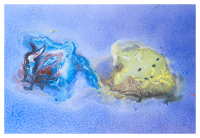Speaker
Reinhard Stock
(Johann-Wolfgang-Goethe Univ. (DE))
Description
The QCD phase transformation line in the plane of temperature T and baryochemical potential mu(B) represents the major property of the QCD phase diagram at finite temperature and mu(B). Recent lattice QCD calculations(1,2) have made predictions for this line, not only at mu(B) near zero but also extending to finite mu(B), up to about 500MeV. At the experimental side, the hadronic multiplicities in A+A collisions reveal an approximate hadro-chemical equilibrium distribution, that is described in the Gibbs grand canonical hadron/resonance ensemble incorporated in the Statistical Hadronization Model(SHM). In priciple, if hadronic species freeze-out occured at, or in the close vicinity of the QCD hadronization line, SHM analysis (carried out at various center of mass energies in A+A collisions) could deliver an estimate of the (T,mu(B)) position of the QCD line.
We have studied hadron production in Pb+Pb collisions at SPS and LHC energies, and the detailed conditions of hadro-chemical freeze-out. We have determined the effects of inelastic and annihilation processes occuring after hadronization that have been traditionally ignored in SHM
analysis. To this end we have empoyed the hybrid version of the microscopic transport model UrQMD(3), in which a hydrodynamic evolution phase is terminated by the Cooper-Frye hadronization prescription, and matched to a final hadron/resonance cascade stage.It turns out that, indeed, the inelastic sector (governing the bulk meson output) freezes out almost directly after hadronization, whereas baryon-antibaryon annihilation and regeneration modify he observed yields, in a pattern depending on the collisional energy(4). Thus, in order to reconstruct the hadronic composition prevailing at hadronization, we have determined the survival factors for all species, occuring during the final cascade stage, from UrQMD, then applying them in the subsequent SHM analysis of central and minimum bias Pb+Pb collisions from the SPS NA49 and the LHC ALICE experiments(4,5). For the latter data we resolve the much discussed
LHC "proton (and antiproton) anomaly" obtaining a universal hadronization temperature of T = 164+/-5MeV at mu(B)=0. And, overall, we shall report a sequence of (energy dependent) points in the (T,mu(B)) plane which follow, closely, the lattice QCD predictions(1,2) up to mu(B)=430MeV.
1. G.Endrodi et al., JHEP 1104(2011)001
2. O.Kaczmarek et al., Phys.Rev.D83(2011)014504
3. H.Petersen et al., Phys.Rev.C78(2008)044901
4. F.Becattini et al., Phys.Rev.Lett. 111(2013)082302
5. F.Becattini et al., arXiv:1405.0710, submitted to PRC
Author
Reinhard Stock
(Johann-Wolfgang-Goethe Univ. (DE))
